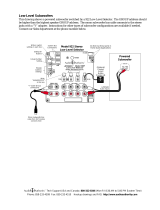
20
01GB02CD-EUR.fm
CDX-NC9950
2-581-922-11 (1)
masterpage:Left
3 Press (ENTER).
The unit starts to search for a station
broadcasting the selected programme type.
Tip
You can also display the PTY list by using the main
menu. During FM reception, press (MENU), and
select “PTY” in “List,” then press (ENTER).
Type of programmes
Note
You cannot use this function in countries/regions
where no PTY data is available.
Setting CT
1 Set “CT” in “Setup” to “ON” (page 32).
Notes
• The CT function may not work even though an RDS
station is being received.
• There might be a difference between the time set by
the CT function and the actual time.
Tip
When the optional NVX-HC1 is connected, the time
can be set by GPS data. For details, see the operating
instructions supplied with the NVX-HC1.
Image Settings
The setting items available in the menu differ
depending on the selected display pattern.
For details on the display patterns, see “Selecting
the display mode and display pattern” on
page 11.
Selecting the face pattern
— Skin
You can select the face pattern for displaying
information on playback/radio reception.
Positions of display items differ depending on
face patterns.
1 Press (MENU).
2 Press < or , repeatedly to select
“Display,” then press (ENTER).
3 Press < or , repeatedly to select
“Skin,” then press (ENTER).
4 Press < or , repeatedly to select the
desired pattern, then press (ENTER).
5 Press (MENU).
The display returns to the normal display.
Tip
For details on the display items, see “Display items” on
page 14, 17 and 18.
Setting the character colour
— Char Color
You can select a character colour to contrast
against background images.
Selecting the character colour
1 Press (MENU).
2 Press < or , repeatedly to select
“Display,” then press (ENTER).
3 Press < or , repeatedly to select
“Char Color,” then press (ENTER).
News (News), Current Affairs (Current
Affairs), Information (Information), Sport
(Sports), Education (Education), Drama
(Drama), Cultures (Culture), Science
(Science), Varied Speech (Varied), Pop
Music (Popular Music), Rock Music (Rock
Music), Easy Listening (Easy Listening),
Light Classics M (Light Classical), Serious
Classics (Classical), Other Music (Other
Music Type), Weather & Metr (Weather),
Finance (Finance), Children’s Progs
(Children’s Programmes), Social Affairs
(Social Affairs), Religion (Religion), Phone
In (Phone In), Travel & Touring (Travel),
Leisure & Hobby (Leisure), Jazz Music
(Jazz Music), Country Music (Country
Music), National Music (National Music),
Oldies Music (Oldies Music), Folk Music
(Folk Music), Documentary (Documentary)





















